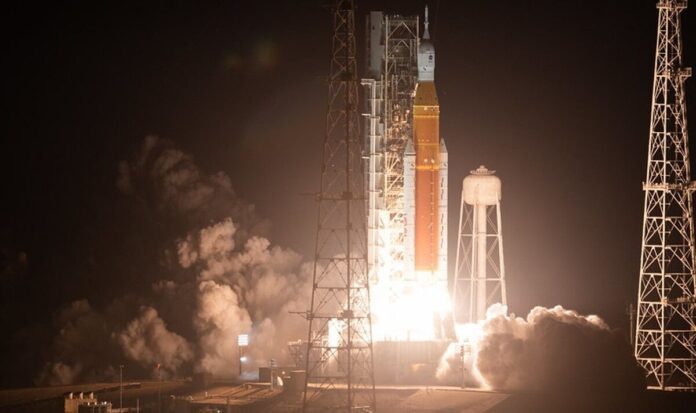NASA’s Artemis 1 finally blasted off from launch pad 39B at the Kennedy Space Center in Cape Canaveral, Florida at 6:41am this morning, several hours behind schedule, and is currently making its way to the Moon in a spectacular mission that comes after months of delays. The $93billion (£78billion) mission will see the unmanned, 322-feet-tall Space Launch System (SLS) rocket send an empty crew Orion capsule into orbit. If successful, the mission will pave the way for returning humans to the Moon for the first time since 1972. NASA’s Artemis 1 mission took off at 6:41am (Image: NASA)The rocket took off after initial launch delays in the early hours of the morning due to a late repair after a hydrogen fuel line leak. Later a lost radar which aids communication between ground teams also sparked concerns but the issue was later resolved and operators finally got the green light for blast off. It is currently travelling at more than 12,000 miles per hour, with everything now appearing to go to plan on the 25-day, 1.3million-mile journey to the Moon and back. The mission is set for a Pacific ocean splashdown on December 11, which is vital for the Artemis 2 and 3 flights that will follow. NASA Artemis launch director Charlie Blackwell-Thompson said in a statement following the successful take-off: “On behalf of all the men and women across our great nation who have worked to bring this hardware together to make this day possible, and for the Artemis generation, this is for you.”NASA Administrator, Bill Nelson, told Newsweek earlier this year: ‘We’re going back to the moon after 50 years, to stay, to learn, to work, to create, to develop new technologies and new systems and new spacecraft in order to go to Mars … This is a tremendous turn of history.’All four of the Orion capsules’ have since been deployed, while the SLS rocket has also reached main engine cutoff (MECO) in the mission timeline. The RS-25 engines have also been powered off and the core stage of the world’s most powerful rocket has also separated.Also aboard the rocket are ten cubesats – box-shaped miniature satellites with 3.9-inch-long faces – as part of its cargo, each with their scientific missions of their own, such as NASA’s Lunar Polar Hydrogen Mapper (LunaH-Map). This is will be studying the presence of water ice at the Moon’s poles.This is a breaking story. More to follow.
NASA’s Artemis 1 finally lifts off on Moon mission finally blasts off
Sourceexpress.co.uk
RELATED ARTICLES


